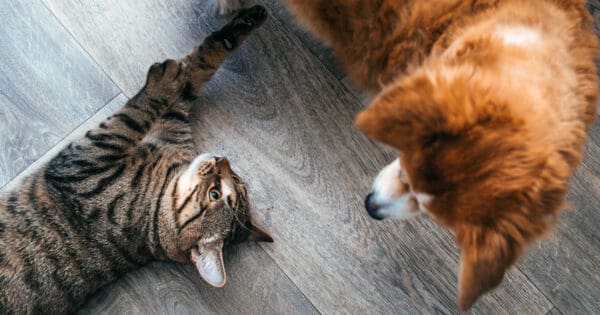
This What’s on the Menu Series was prepared by the students of the College of Veterinary Medicine.
Maintenance Diet
Around 12 months of age your kitten’s growth diet may be switched to an ‘adult maintenance’ diet. This transition should be completed slowly over one week to ensure acceptance of the new food and to prevent gastrointestinal upset. Place the new adult maintenance food in an identical size and shaped bowl next to the growth food and allow your cat the option of both types for several days before gradually decreasing amount of growth food.
It’s always a good idea to try and observe how many times your pet nibbles at her food bowl over the course of a day. It is not unusual for cats to visit their food bowl up to 20 times. Cats that do not eat adequately are at risk of getting sick. If you’re worried about whether your cat is eating adequately, speak with your veterinarian.
Toys
Kittens like to play, and playing is good exercise. Toys can be homemade. A piece of paper rolled up into a ball is good for the kitten to bat and chase around. Look around your home for things your pet can explore, like bags and boxes. Extra carpet or even cardboard can be used for a scratching pad. And of course all kinds of toys are available at pet stores.
Bedding
Kittens need a warm and quiet place to sleep at night. There are all kinds of beds to chose from at pet stores. However, a small cardboard box with a blanket that the kitten can cuddle up in, works well too.
Why is nutrition important?
Providing proper nutrition is important to maximize your kitten’s daily health, and his/her life span. Dietary deficiencies or excesses of some vitamins, minerals, and fat may cause serious medical problems.
Cats Are Not Small Dogs!
The Unique Nutrition Needs Of Cats:
- Obligate carnivores (require meat in their diet)
- Taurine (an ammino acid needed for optimal heart health)
- Minimal carbohydrates
- Arachadonic Acid (an essential fatty acid)
- Some vitamins in certain forms are not available in dog foods; for this reason, cats should not be fed dog foods.
What to Feed?
The most important nutrient for all animals is water. Your kitten should have access to clean fresh water throughout the day. Try not to leave water bowls half-empty, but keep them full.
The majority of commercial kitten foods are appropriate, which means they are balanced to meet the needs of growing cats. The pet food label should have a statement that says the food meets or exceeds the Association of American Feed Control Officials (AAFCO) minimum requirements for a complete and balanced diet for growing cats.
Kittens should be fed free choice so that they can ‘nibble’ and enjoy many small meals throughout the day. A dry diet may be left out, but canned food should be refrigerated after it has been opened.
Cats are obligate carnivores (requiring meat); which means their diet needs to contain high levels of animal protein. It’s the animal protein that provides amino acids like taurine, and animal fat that provides an essential fatty acid cats need, called arachadonic acid.
Treats
Treats should make up less than 20% of your kitten’s total dietary intake. Avoid feeding people foods. Most commercially available cat treats are dry kibble or soft treats containing 2 to 6 calories per piece. It can be both challenging and fun to try and train your kitten-using treats can help!
Body Condition Scoring
Kittens should gain about 100 grams of body weight (approximately 1/5 of a lb.) per month until 20 weeks of age. After 20 weeks (5 months) the growth rate slows down. Kittens should reach 80% of their adult weight by 6 months and full adult weight by 10 months of age.
Body condition scoring (BCS) is the best method for evaluating both the weight and lean muscle mass of your growing kitten. BCS involves feeling your pet’s body to judge the fat covering the ribs. If the ribs and spine cannot be felt due to excessive fat covering, your kitten is getting overweight. Alternatively, if the ribs and spine are easily felt with very little fat covering, the animal is underweight. An ideal BCS is about 5 on a scale of 1 to 9 (1= very thin to 9 = obese).
What to Avoid
For the curious kitten, there are many things around the house that have the potential to be deadly. Do you remember the saying “curiosity killed the cat?” Avoid exposure to the following:
- House plants including lilies and poinsettias
- Human foods such as onions, garlic, and chocolate
- Topical flea and tick preventatives made for dogs
- Medications particularly acetaminophen (Tylenol)
- Plastic containers, bags, toys
- Tobacco products
- String from rugs, pillows, or clothing
- Electrical cords
- Stuffed animals and children’s toys
- Paper from magazines and books
Summary
- Make sure your kitten always has access to fresh water
- Feed kitten food that is complete and balanced for the first year of your cat’s life
- Limit treats to 20% or less of total food intake each week
- Monitor your kitten’s appetite daily, and body condition monthly
Consult with your veterinarian anytime you have questions about your pet’s health.
Reposted from Veterinary Medical Center-College of Veterinary Medicine.



